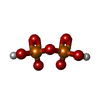Entry Database : PDB / ID : 3p7zTitle Crystal structure of the Neurofibromin Sec14-PH module containing the patient derived mutation I1584V Neurofibromin Keywords / / / / / Function / homology Function Domain/homology Component
/ / / / / / / / / / / / / / / / / / / / / / / / / / / / / / / / / / / / / / / / / / / / / / / / / / / / / / / / / / / / / / / / / / / / / / / / / / / / / / / / / / / / / / / / / / / / / / / / / / / / / / / / / / / / / / / / / / / / / / / / / / / / / / / / / / / / / / / / / / / / / Biological species Homo sapiens (human)Method / / / Resolution : 2.65 Å Authors Welti, S. / Scheffzek, K. Journal : Hum.Mutat. / Year : 2011Title : Structural and biochemical consequences of NF1 associated nontruncating mutations in the Sec14-PH module of neurofibromin.Authors : Welti, S. / Kuhn, S. / D'Angelo, I. / Brugger, B. / Kaufmann, D. / Scheffzek, K. History Deposition Oct 13, 2010 Deposition site / Processing site Revision 1.0 Dec 8, 2010 Provider / Type Revision 1.1 Jul 13, 2011 Group Revision 1.2 Jul 17, 2019 Group / Data collection / Refinement description / Category / softwareItem / _software.name / _software.versionRevision 1.3 Nov 6, 2024 Group Advisory / Data collection ... Advisory / Data collection / Database references / Derived calculations / Structure summary Category chem_comp_atom / chem_comp_bond ... chem_comp_atom / chem_comp_bond / database_2 / pdbx_entry_details / pdbx_modification_feature / pdbx_unobs_or_zero_occ_atoms / struct_ref_seq_dif / struct_site Item _database_2.pdbx_DOI / _database_2.pdbx_database_accession ... _database_2.pdbx_DOI / _database_2.pdbx_database_accession / _struct_ref_seq_dif.details / _struct_site.pdbx_auth_asym_id / _struct_site.pdbx_auth_comp_id / _struct_site.pdbx_auth_seq_id
Show all Show less
 Yorodumi
Yorodumi Open data
Open data Basic information
Basic information Components
Components Keywords
Keywords Function and homology information
Function and homology information Homo sapiens (human)
Homo sapiens (human) X-RAY DIFFRACTION /
X-RAY DIFFRACTION /  SYNCHROTRON /
SYNCHROTRON /  MOLECULAR REPLACEMENT / Resolution: 2.65 Å
MOLECULAR REPLACEMENT / Resolution: 2.65 Å  Authors
Authors Citation
Citation Journal: Hum.Mutat. / Year: 2011
Journal: Hum.Mutat. / Year: 2011 Structure visualization
Structure visualization Molmil
Molmil Jmol/JSmol
Jmol/JSmol Downloads & links
Downloads & links Download
Download 3p7z.cif.gz
3p7z.cif.gz PDBx/mmCIF format
PDBx/mmCIF format pdb3p7z.ent.gz
pdb3p7z.ent.gz PDB format
PDB format 3p7z.json.gz
3p7z.json.gz PDBx/mmJSON format
PDBx/mmJSON format Other downloads
Other downloads 3p7z_validation.pdf.gz
3p7z_validation.pdf.gz wwPDB validaton report
wwPDB validaton report 3p7z_full_validation.pdf.gz
3p7z_full_validation.pdf.gz 3p7z_validation.xml.gz
3p7z_validation.xml.gz 3p7z_validation.cif.gz
3p7z_validation.cif.gz https://data.pdbj.org/pub/pdb/validation_reports/p7/3p7z
https://data.pdbj.org/pub/pdb/validation_reports/p7/3p7z ftp://data.pdbj.org/pub/pdb/validation_reports/p7/3p7z
ftp://data.pdbj.org/pub/pdb/validation_reports/p7/3p7z Links
Links Assembly
Assembly
 Components
Components Homo sapiens (human) / Gene: NF1 / Plasmid: pETM11 / Production host:
Homo sapiens (human) / Gene: NF1 / Plasmid: pETM11 / Production host: 
 X-RAY DIFFRACTION / Number of used crystals: 1
X-RAY DIFFRACTION / Number of used crystals: 1  Sample preparation
Sample preparation SYNCHROTRON / Site:
SYNCHROTRON / Site:  ESRF
ESRF  / Beamline: ID29 / Wavelength: 0.979 Å
/ Beamline: ID29 / Wavelength: 0.979 Å Processing
Processing MOLECULAR REPLACEMENT / Resolution: 2.65→49 Å / SU ML: 0.12 / σ(F): 1.98 / Stereochemistry target values: ML
MOLECULAR REPLACEMENT / Resolution: 2.65→49 Å / SU ML: 0.12 / σ(F): 1.98 / Stereochemistry target values: ML Movie
Movie Controller
Controller



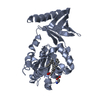

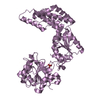
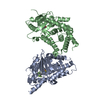


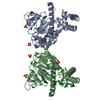
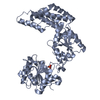
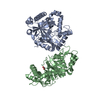



 PDBj
PDBj










